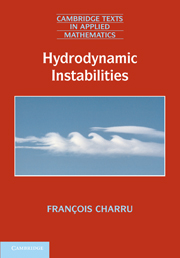Book contents
- Frontmatter
- Contents
- Foreword
- Preface
- Video resources
- 1 Introduction
- 2 Instabilities of fluids at rest
- 3 Stability of open flows: basic ideas
- 4 Inviscid instability of parallel flows
- 5 Viscous instability of parallel flows
- 6 Instabilities at low Reynolds number
- 7 Avalanches, ripples, and dunes
- 8 Nonlinear dynamics of systems with few degrees of freedom
- 9 Nonlinear dispersive waves
- 10 Nonlinear dynamics of dissipative systems
- 11 Dynamical systems and bifurcations
- Appendix A The Saint-Venant equations
- References
- Index
5 - Viscous instability of parallel flows
Published online by Cambridge University Press: 05 August 2011
- Frontmatter
- Contents
- Foreword
- Preface
- Video resources
- 1 Introduction
- 2 Instabilities of fluids at rest
- 3 Stability of open flows: basic ideas
- 4 Inviscid instability of parallel flows
- 5 Viscous instability of parallel flows
- 6 Instabilities at low Reynolds number
- 7 Avalanches, ripples, and dunes
- 8 Nonlinear dynamics of systems with few degrees of freedom
- 9 Nonlinear dispersive waves
- 10 Nonlinear dynamics of dissipative systems
- 11 Dynamical systems and bifurcations
- Appendix A The Saint-Venant equations
- References
- Index
Summary
Introduction
The inertial instability of parallel flows described in the preceding chapter is associated with the existence of an inflection point in the velocity profile. This is the principal instability of parallel or quasi-parallel shear flows at large Reynolds number and far from walls or interfaces, such as mixing layers, jets, and wakes. We have seen that the order of magnitude of the growth rate is U/δ, where U is the difference of the speeds on either side of the vorticity layer of thickness δ, and that viscosity plays only a diffusive role tending to attenuate the growth rate. The instability of flow profiles without inflection points is profoundly different. Let us consider two fundamental flows: plane Poiseuille flow and boundary layer flow. Observation shows that plane Poiseuille flow is unstable beyond a certain Reynolds number. Similarly, a boundary layer on a surface becomes unstable at some distance from the leading edge. However, these two flows do not possess an inflection point, and so, ignoring viscosity, they are stable according to the Rayleigh theorem. On the other hand, the growth rate of the observed instabilities is much smaller than would be expected for an inertial instability. It is therefore clearly important to investigate the role played by viscosity, which is the goal of the present chapter. We shall see that viscosity has two effects: the expected stabilizing dissipative effect, and also a destabilizing effect.
- Type
- Chapter
- Information
- Hydrodynamic Instabilities , pp. 139 - 170Publisher: Cambridge University PressPrint publication year: 2011



